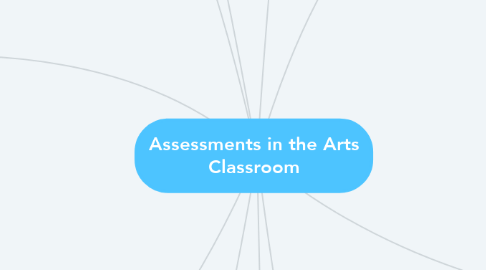Assessments in the Arts Classroom
by Pari Valad


1. Performance-based
1.1. DEFINE: A type of assessment where students are evaluated based on their performance and active participation.
1.2. PURPOSE: To display the student's deep understanding of the subject matter.
1.3. ADVANTAGES: In order to for students to perform they must learn how to use their understanding of the subject. Sparks student's creativity and connection to subject matter, creating students who are actively engaged.
1.4. DISADVANTAGES: Does not usually have an end result that can be quantified and then then turned into accurate data.
1.5. DESIGN: Can take place in many forms, but is most often a type of project based learning.
1.6. EXAMPLE: Having students use their understanding of 1 point perspective to design the interior of their dream bedroom.
2. High-stakes
2.1. DEFINE: Assessment used to make high level decisions that impact students, instructors, and administrators.
2.2. PURPOSE: To create accountability within the school structure.
2.3. ADVANTAGES: Usually creates state and national data.
2.4. DISADVANTAGES: Does not gauge all types of learners understanding based on the design of the assessment.
2.5. DESIGN: Takes place in the form of a standardized test.
2.6. EXAMPLE: Standards of Learning Tests for the state of Virginia. (Thankfully most districts do not have an Arts exam)
3. Authentic
3.1. DEFINE: An assessment where students are asked to perform real world tasks.
3.2. PURPOSE: To evaluate the application of knowledge and skills.
3.3. ADVANTAGES: Aims to create productive citizens and students with real-world skills, and create direct evidence of student learning.
3.4. DISADVANTAGES: Does not test for (depending on the content) critical understanding. Ex: Student can perform 1 point perspective and create a mathematically correct image, but does not understand why.
3.5. DESIGN: Must utilize a connection to the real world, and is often student-structured rather than teacher-structured.
3.6. EXAMPLE: Having students use color relationships to design a PSA style poster.
4. Self-assessment
4.1. DEFINE: When a student assesses themselves.
4.2. PURPOSE: To have student's actively participate in their learning, and understand the assessment process itself.
4.3. ADVANTAGES: Student's gain personally knowledge about themselves and how they learn.
4.4. DISADVANTAGES: Could lead to students feeling self conscious depending on their personal attitude.
4.5. DESIGN: Can take place in many forms, and could be written or verbal such as in a group critique where the student defends their decisions.
4.6. EXAMPLE:A rubric in which the students evaluate their art work and give themselves a rating for each part of the rubric.
5. RESOURCES:
5.1. Diagnostic and Formative Assessment. (2017, April 07). Retrieved May 08, 2017, from http://serc.carleton.edu/introgeo/assessment/formative.html
5.2. E. (2010, August 03). Retrieved May 07, 2017, from https://www.youtube.com/watch?v=b9OBhKzh1BM
5.3. M. (2011, January 13). Retrieved May 07, 2017, from https://www.youtube.com/watch?v=rL54bfmZPzY
5.4. Peer-Assessment. (n.d.). Retrieved May 08, 2017, from https://www.cte.cornell.edu/teaching-ideas/assessing-student-learning/peer-assessment.html
5.5. Popham, W. J. (2005, March 23). Standardized Testing Fails the Exam. Retrieved May 07, 2017, from https://www.edutopia.org/standardized-testing-evaluation-reform
5.6. S. (2010, November 30). Retrieved May 07, 2017, from https://www.youtube.com/watch?v=rJxFXjfB_B4
5.7. University, C. M. (n.d.). Retrieved May 08, 2017, from https://www.cmu.edu/teaching/assessment/basics/formative-summative.html
5.8. (n.d.). Retrieved May 08, 2017, from http://jfmueller.faculty.noctrl.edu/toolbox/whatisit.htm
6. Diagnostic
6.1. DEFINE: A type of "pre-assessment"
6.2. PURPOSE: To know a students prior knowledge to material.
6.3. ADVANTAGES: Informs instructors on what content they need to focus on.
6.4. DISADVANTAGES: Could possibly result in scattered data, if all students have different levels of understanding.
6.5. DESIGN: Short assessments that focus on key concepts and ideas from the content, rather than details about subject matter.
6.6. EXAMPLE: Giving students a pop quiz on content they learned in art class the year previously.
7. Formative
7.1. DEFINE: Assessments that serve as "check points" for student learning. They are usually informal.
7.2. PURPOSE: To gauge how much a student has learned about the content.
7.3. ADVANTAGES: Gives the instructor a bench mark on student progress and understanding of material.
7.4. DISADVANTAGES: Depending on design data taken from a formative assessment may not be as accurate as something like a Summative assessment such as a formal test.
7.5. DESIGN: Formative assessments can come in all forms, but must include descriptive feedback. Student should be able to revise efforts and then be assessed again. The process of formative assessment is on-going.
7.6. EXAMPLES:
7.6.1. Playing a Kahoot game to check understanding on Art Historical terms.
7.6.2. Providing One on one feed back about a student's Art Project.
7.6.3. Having the students take something they're doing as part of the summative assessment (full art project on 1 point perspective) and having them recreate some aspect of it as a sketchbook prompt.
8. Summative
8.1. DEFINE: The final assessment of a Unit, or final project.
8.2. PURPOSE: To evaluate student learning.
8.3. ADVANTAGES: Creates accurate data.
8.4. DISADVANTAGES: Usually takes place as the end of a Unit, so after students are expected to move on to different content, leaving little room for any type of "relearning"
8.5. DESIGN: Usually takes form in High-stakes testing, or a very detailed rubric for a project.
8.6. EXAMPLE:
8.6.1. Final Art project using a specific skill set, such as 1 point perspective.
8.6.2. Art History exam where students are expected to have memorized artist, dates, and time periods connected to visual images.

